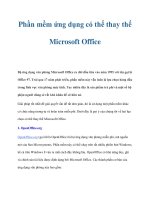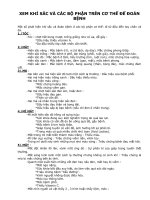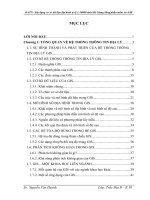với phần mềm ebib teachers pro người dùng có thể dễ dàng tạo đề thi và trộn ra 24 mã đề bằng cách đưa trực tiếp đề thi từ file word vào phần mềm
Bạn đang xem bản rút gọn của tài liệu. Xem và tải ngay bản đầy đủ của tài liệu tại đây (133.34 KB, 7 trang )
<span class='text_page_counter'>(1)</span><div class='page_container' data-page=1>
<b>SỞ GIÁO DỤC & ĐÀO TẠO……</b>
ĐỀ THI MINH HỌA
<i>(Đề thi gồm có 40 câu hỏi)</i>
<b>KÌ THI THPT QUỐC GIA NĂM …... </b>
<b>Môn thi: TIẾNG ANH</b>
<i>Thời gian làm bài: 60 phút, không kể thời gian phát đề</i>
<b>Họ, tên thí sinh: ………</b> <b>Mã đề thi: 401</b>
<b>Số báo danh: ……….</b>
<b>[NOIDUNG]</b>
<i><b>Mark the letter A, B, C, or D on your answer sheet to indicate the correct answer to each of the</b></i>
<i><b>following question.</b></i>
<b>Question 1: Your drink cost €40, you gave me a €50 note and here is your _______.</b>
<b>A. change</b> <b>B. supply</b> <b>C. cash</b> <b>D. cost</b>
<b>Question 2: People can become very _______ when they are stuck in traffic for a long time.</b>
<b>A. single-minded</b> <b>B. bad-tempered</b> <b>C. even-tempered</b> <b>D. even-handed</b>
<b>Question 3: Jasmine, _______ , grows only in warm places.</b>
<b>A. is a vine plant with fragrant flowers</b>
<b>B. a vine plant with fragrant flowers</b>
<b>C. that is a vine plant with fragrant flowers</b>
<b>D. a vine plant with fragrant flowers it is</b>
<b>Question 4: Our car _______ because it’s not where it’s normally parked in the parking lot.</b>
<b>A. should have been stolen</b>
<b>B. would have been stolen</b>
<b>C. must have been stolen</b>
<b>D. need have been stolen</b>
<b>Question 5: Though we were _______ after hard-working days, we tried to help our parents</b>
redecorate the house to welcome Tet.
<b>A. exhaustion</b> <b>B. exhausted</b> <b>C. exhausting</b> <b>D. exhaustive</b>
<b>Question 6: At the 2015 Women in the World Summit, Hillary Clinton asserted that “ _______</b>
cultural codes, religious beliefs and structural biases have to be changed”.
<b>A. deep-seated</b> <b>B. deep-seating</b> <b>C. seated-deep</b> <b>D. seating -deep</b>
<b>Question 7: It’s important that we _______ this message _______ to young people.</b>
<b>A. go /over</b> <b>B. get/down</b> <b>C. get/over</b> <b>D. go/for</b>
<b>Question 8: Miss Diligent did nine hour’s _______ studying a day for her exam.</b>
<b>A. heavy</b> <b>B. solid</b> <b>C. powerful</b> <b>D. big</b>
<b>Question 9: “At the start of the 19th century, the highest- _______ newspaper in the United Kingdom</b>
was The Morning Post, which sold around 4,000 copies per day.”
<b>A. distribution</b> <b>B. coverage</b> <b>C. circulation</b> <b>D. sales</b>
<b>Question 10: Marketing this new product will be expensive, but _______ it will be worth the money</b>
we spend on it.
<b>A. at long last</b> <b>B. down the years</b> <b>C. in the event</b> <b>D. in the long run</b>
<b>Question 11: Laura starts a conversation with Maya- Jane’s sister.</b>
Laura: “You must be Jane's sister. Glad to meet you.”
Maya: “ _______ ”
<b>A. I am, either.</b>
<b>B. So I am. I'm glad.</b>
<b>C. What do you do?</b>
<b>D. Me too.</b>
</div>
<span class='text_page_counter'>(2)</span><div class='page_container' data-page=2>
<b>A. refused</b> <b>B. denied</b> <b>C. objected</b> <b>D. reject</b>
<b>Question 13: Lien was walking her dogs in the park, she met Lan accidentally.</b>
Lan: “How lovely your pets are!”
Lien: “ _______ .”
<b>A. Thank you, it's nice of you to say so</b>
<b>B. Really? They are</b>
<b>C. Can you say that again</b>
<b>D. I love them, too</b>
<b>Question 14: If our team _______ U23Uzbekistan in the final match, we _______ the champion now.</b>
<b>A. have defeated/ would be</b>
<b>B. defeats/ will be</b>
<b>C. defeated/ would be</b>
<b>D. had defeated/ would be</b>
<i><b>Mark the letter A, B, C, or D on your answer sheet to indicate the underlined part that needs</b></i>
<i><b>correction in each of the following questions.</b></i>
<b>[GC]</b>
<b>Question 15: Transplanting organs such hearts and kidneys had proved easier than transplanting</b>
muscles.
<b>Question 16: On the floor of the Pacific Ocean is hundreds of flat-tipped</b>
mountains more than a mile
beneath sea level.
<b>Question 17: Paint must bestirred and sometimes dilution before it is applied.</b>
<b>[/GC]</b>
<i><b>Read the following passage and mark the letter A, B, C, or D on your answer sheet to indicate the</b></i>
<i><b>correct answer to each of the question from 18 to 25.</b></i>
<b>[GROUP]</b>
The principle of use and disuse states that those parts of organisms' bodies that are used grown
<b>larger. Those parts that are not tend to wither away. It is an observed fact that when you exercise</b>
<b>particular muscles, they grow. Those that are never used dimish. By examining a man's body, we can</b>
tell which muscles he uses and which he doesn't. We may even be able to guess his profession or his
reaction. Enthusiasts of the "body- building" cult make use of the principle of use and disuse to "build"
their bodies, almost like a piece of sculpture, into whatever unnatural shape is demanded by fashion in
this peculiar minority culture. Muscles are not the only parts of the body that respond to use in this
kind of way. Walk barefoot and you acquire harder skin on your soles. It is easy to tell a farmer from a
bank teller by looking at their hands alone. The farmer's hands are horny, hardened by long exposure
to rough work. The teller’s hands are relatively soft.
The principle of use and disuse enables animals to become better at the job of surviving in their
world, progressively better during their lifetime as a result of living in that world. Humans, through
direct exposure to sunlight, or lack of it, develop a skin color which equips them better to survive in
the particular local conditions.
</div>
<span class='text_page_counter'>(3)</span><div class='page_container' data-page=3>
This can be represented as an instance of the principle of use and disuse: skin goes brown when it is
"used", and fades to white when it is not.
<b>Question 18: What does the passage mainly discuss?</b>
<b>A. How the principles of use and disuse change people’s concepts of themselves.</b>
<b>B. The changes that occur according to the principle of use and disuse.</b>
<b>C. The way in which people change themselves to conform to fashion.</b>
<b>D. The effects of the sun on the principle of use and disuse.</b>
<b>Question 19: The phrase “wither away” in bold is closest in meaning to _______ .</b>
<b>A. split</b> <b>B. rot</b> <b>C. perish</b> <b>D. shrink</b>
<b>Question 20: The word “Those” in bold refers to _______ .</b>
<b>A. organisms</b> <b>B. bodies</b> <b>C. parts</b> <b>D. muscles</b>
<b>Question 21: According to the passage, men who body build _______.</b>
<b>A. appear like sculptures</b>
<b>B. change their appearance</b>
<b>C. belong to strange cults</b>
<b>D. are very fashionable</b>
<b>Question 22: From the passage, it can be inferred that author views body building _______ .</b>
<b>A. with enthusiasm</b>
<b>B. as an artistic from</b>
<b>C. with scientific interest</b>
<b>D. of doubtful benefit</b>
<b>Question 23: It can be inferred from the passage that the principle of use and disuse enables organisms</b>
to _______ .
<b>A. change their existence</b>
<b>B. automatically benefit</b>
<b>C. survive in any condition </b>
<b>D. improve their lifetime</b>
<b>Question 24: The author suggests that melanin _______ .</b>
<b>A. is necessary for the production of vitamin</b>
D
<b>B. is beneficial in sunless climates</b>
<b>C. helps protect fair-skinned people</b>
<b>D. is a synthetic product</b>
<b>Question 25: In the second paragraph, the author mentions sun tanning as an example of _______ .</b>
<b>A. humans improving their local condition</b>
<b>B. humans surviving in adverse conditions</b>
<b>C. humans using the principle of use and disuse</b>
<b>D. humans running the risk of skin cancer</b>
<b>[/GROUP]</b>
<i><b>Mark the letter A, B, C, or D on your answer sheet to indicate the word whose underlined part that</b></i>
<i><b>differs from the other three in the pronunciation in each of the following questions.</b></i>
<b>Question 26: A. expand</b> <b>B. stagnant</b> <b>C. vacancy</b> <b>D. applicant</b>
<b>Question 27: A. attained</b> <b>B. resolved</b> <b>C. disused</b> <b>D. decreased</b>
<i><b>Mark the letter A, B, C, or D on your answer sheet to indicate the word that differs from the other</b></i>
<i><b>three in the position ofprimary stress in each of the following questions.</b></i>
<b>Question 28: A. flourish</b> <b>B. season</b> <b>C. product</b> <b>D. today</b>
</div>
<span class='text_page_counter'>(4)</span><div class='page_container' data-page=4>
<i><b>Read the following passage and mark the letter A, B, C or D on your answer sheet to indicate the</b></i>
<i><b>correct word or phrase that best fits each of the numbered blanks.</b></i>
<b>[NUMBERING]</b>
<b>THE HISTORY OF WRITING</b>
The development of writing (30) _______ a huge difference to the world and might see it as the
beginning of the media. Pieces of pottery with marks on that are probably numbers have been
discovered in China (31) _______ date from around 4000 BC. Hieroglyphics and other forms of
"picture writing" developed in the area around Mesopotamia (modern-day Iraq), where the ancient
Sumerian civilization was based, from around 3300 BC onwards. However, the first (32) _______
alphabet was used by the Phoenicians around 1050 BC. Their alphabet had 22 letters and it is
estimated that it lasted for 1000 years. The first two signs were called "aleph" and "beth", which in
Greek became "alpha" and "beta", which gave us the modern word "alphabet".
The modern European alphabet is based on the Greek and spread (33) _______ other European
countries under the Romans. A number of changes took place as time passed. The Romans added the
letter G, and the letter J and V were unknown to people in Shakespeare's time.
If we (34) _______ the history of punctuation, we also find some interesting facts. The Romans
used to write quaesto at the end of a sentence in order to show that it was a Question. They started to
<i><b>write Qo in place of the whole word, and then put the Q above the o. In the end, that became the</b></i>
<i><b>question mark "?" </b></i>
<b>Question 30: A. did</b> <b>B. had</b> <b>C. made</b> <b>D. took</b>
<b>Question 31: A. where</b> <b>B. that</b> <b>C. who</b> <b>D. when</b>
<b>Question 32: A. true</b> <b>B. accurate</b> <b>C. exact</b> <b>D. precise</b>
<b>Question 33: A. to</b> <b>B. in</b> <b>C. with</b> <b>D. for</b>
<b>Question 34: A. look into</b> <b>B. bring on</b> <b>C. make off</b> <b>D. hold up</b>
<b>[/NUMBERING]</b>
<i><b>Read the following passage and mark the letter A, B, C or D on your answer sheet to indicate the</b></i>
<i><b>correct answer to each of the questions.</b></i>
<b>[GROUP]</b>
<b>ENGLISH SEVENTH MEETING “SAN ANDREAS FAULT”</b>
</div>
<span class='text_page_counter'>(5)</span><div class='page_container' data-page=5>
tremors are interpreted as safe, since they are understood to be pressure that releases without causing
much damage.
It is worth noting that the San Andreas Fault passes uncomfortably close to several major
metropolitan areas, including Los Angeles and San Francisco. In addition, the San Andreas Fault has
created smaller fault systems, many of which underlie the smaller towns and cities along the California
<b>coast. For this reason, Californians have long anticipated the recurrence of what they refer to as “the</b>
<b>Big One”, a chain reaction of destructive earthquakes that would measure near 8 on the Richter scale,</b>
similar in intensity to those that occurred in 1857 and 1906. Such a quake would wreak devastating
effects on the life and property in the region. Unfortunately, as pressure continues to build along the
fault, the likelihood of such an earthquake increases substantially.
<b>Question 35: What is the author’s main purpose in the passage?</b>
<b>A. To describe the San Andreas Fault.</b>
<b>B. To give a definition of a fault.</b>
<b>C. To explain the reason for tremors and earthquakes.</b>
<b>D. To classify different kinds of faults.</b>
<b>Question 36: How does the author define the San Andreas Fault?</b>
<b>A. A plate that underlies the North American continent.</b>
<b>B. A crack in the Earth’s crust between two plates.</b>
<b>C. Occasional tremors and earthquakes.</b>
<b>D. Intense pressure that builds up.</b>
<b>Question 37: The word originates in paragraph 1 could best be replaced by _______ .</b>
<b>A. gets wider</b>
<b>B. changes direction</b>
<b>C. begins</b>
<b>D. disappears</b>
<b>Question 38: In which direction does the western side of the fault move?</b>
<b>A. West</b> <b>B. East</b> <b>C. North</b> <b>D. South</b>
<b>Question 39: The word its in the paragraph 1 refers to _______ .</b>
<b>A. San Francisco</b> <b>B. ocean</b> <b>C. coast</b> <b>D. fault</b>
<b>Question 40: Along the San Andreas Fault, tremors are _______ .</b>
<b>A. small and insignificant</b>
<b>B. rare, but disastrous</b>
<b>C. frequent events</b>
<b>D. very unpredictable</b>
<b>Question 41: The phrase “the Big One” refers to which of the following?</b>
<b>A. A serious earthquake</b>
<b>B. The San Andreas Fault</b>
<b>C. The river scale</b>
<b>D. California</b>
<b>[/GROUP]</b>
<i><b>Mark the letter A, B, C or D on your answer sheet to indicate the word(s) CLOSEST in meaning to</b></i>
<i><b>the underlined word(s) in each of the following questions.</b></i>
<b>Question 42: The Chernobyl disaster occurred on 26 April 1986 when the Chernobyl Nuclear Power</b>
<b>Plant near Pripyat, a town in northern Ukraine, went off.</b>
<b>A. demolished</b> <b>B. ran</b> <b>C. developed</b> <b>D. exploded</b>
<b>Question 43: Prior to its evacuation Chernobyl was inhabited by 16,000 people but is now populated</b>
only by Zone administrative personnel and a number of residents who refused to leave their homes or
subsequently returned.
</div>
<span class='text_page_counter'>(6)</span><div class='page_container' data-page=6>
<i><b>Mark the letter A, B, C, or D on your answer sheet to indicate the word(s) OPPOSITE in meaning</b></i>
<i><b>to the underlined word(s) in each of the following questions.</b></i>
<b>Question 44: The Democratic Party now have 59.9% of the votes, so they’re home and dry.</b>
<b>A. returning home</b>
<b>B. safe and successful</b>
<b>C. disappointed</b>
<b>D. at risk of losing</b>
<b>Question 45: Having served in the White House for 34 years and assisted 8 presidents, Eugene Allen</b>
<b>experienced crucial moments in American history during his time here.</b>
<b>A. unimportant</b> <b>B. special</b> <b>C. diverse</b> <b>D. complex</b>
<i><b>Mark the letter A, B, C, or D on your answer sheet to indicate the sentence that best combines each</b></i>
<i><b>pair of sentences in the following questions.</b></i>
<b>Question 46: Many doctors and nurses on duty during holidays don’t have time to relax. They don’t</b>
have time to meet up with their families.
<b>A. Many doctors and nurses on duty during holidays have time neither to relax nor to meet up with</b>
their families.
<b>B. Many doctors and nurses on duty during holidays have time neither to relax or to meet up with</b>
their families.
<b>C. Many doctors and nurses on duty during holidays have time either to relax or to meet up with</b>
their families.
<b>D. Many doctors and nurses on duty during holidays have time not only to relax but also to meet up</b>
with their families.
<b>Question 47: The boy lost several of his fingers because of firecrackers. The doctors are operating on</b>
him.
<b>A. The boy who lost several of his fingers because of firecrackers is being operating on.</b>
<b>B. The boy whom the doctors are operating on him lost several of his fingers because of firecrackers.</b>
<b>C. The boy was whom the doctors are operating on him lost several of his fingers because of</b>
firecrackers.
<b>D. The doctors are operating on the boy who lost several of his fingers because of firecrackers.</b>
<i><b>Mark the letter A, B, C, or D on your answer sheet to indicate the sentence that is closest in</b></i>
<i><b>meaning to each of the following questions.</b></i>
<b>Question 48: Father said “Albert, if you break your promise, nobody will respect you.”</b>
<b>A. Father said that if Albert broke his promise, nobody would respect him.</b>
<b>B. Father warned Albert that if he broke his promise, nobody would respect him.</b>
<b>C. Father told that if Albert broke his promise, nobody would respect him.</b>
<b>D. Father said to Albert if he breaks his promise, nobody will respect him.</b>
<b>Question 49: People say that products are sold in this market at suitable prices.</b>
<b>A. Products are said to be selling in this market at suitable prices.</b>
<b>B. Products are said to have sold in this market at suitable prices.</b>
<b>C. This market is said to have sold products at suitable prices.</b>
<b>D. This market is said to sell products at suitable prices.</b>
</div>
<span class='text_page_counter'>(7)</span><div class='page_container' data-page=7>
<b>A. We could have been able to go to the final match with the coach’s flexible strategies.</b>
<b>B. If we could be able to go to the final match, the coach would have flexible strategies.</b>
<b>C. If we couldn’t have been able to go to the final match, we would have had the coach’s flexible</b>
strategies.
</div>
<!--links-->









